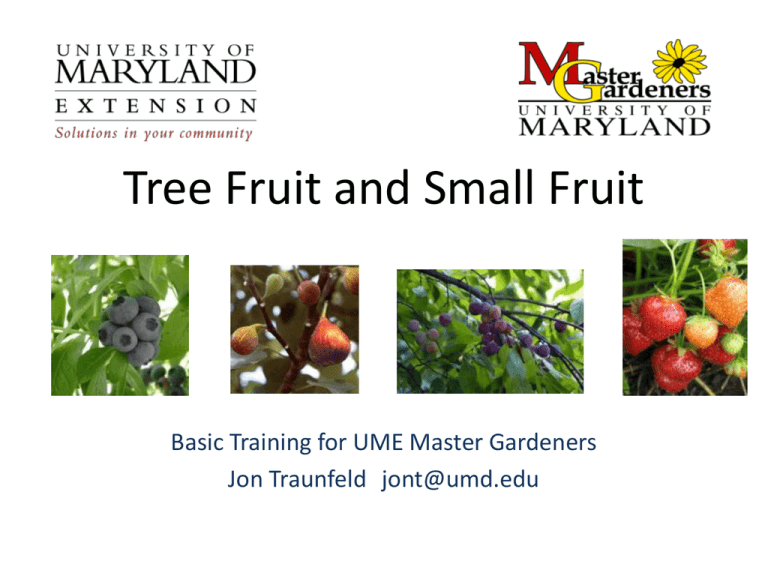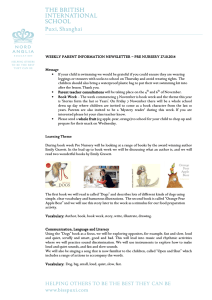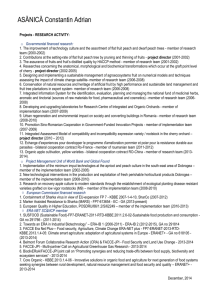MG16 Tree Fruit and Small Fruit
advertisement

Tree Fruit and Small Fruit Basic Training for UME Master Gardeners Jon Traunfeld jont@umd.edu Reasons to grow fruit • Flavor and quality, high store price, versatility, health benefits • It’s a challenge – lots to learn (part science, art, and mystery) – long lived plants that require timely care and attention each season • But please… start small; start with small fruit Fruit plants grown in Maryland Tree fruit Major- apple, European pear, peach, plum (Asian and European), sweet and tart cherry, fig Minor- Asian persimmon, Asian pear, lemon, lime, orange, banana, pawpaw* Small fruit (take less space, more forgiving, can be grown organically, less expensive to maintain and easier to dig up) Major- strawberry, blackberry*, raspberry,* blueberry*, grape* Minor- currant, gooseberry, jostaberry, hardy kiwi, elderberry*, beach plum*, chokeberry*, medlar, citron *Native to mid-Atlantic Will I have to spray a lot? Pest problems (commercial growers spray): Peach (many pests) Apple (many pests) Sweet cherry Japanese plum Grape Can grow these organically: Fig Raspberry/blackberry Currant Strawberry Blueberry Asian pear Asian persimmon European plum (maybe) Sour cherry How do fruit plants compare to tomato plants? • Perennials that require 12-month attention • Require “hardening” (chilling hours) to survive winter and produce fruit • Maximum yields come with the correct balance of root, leaf, and fruit growth • Important to know when and where they produce flower buds and fruit • Correct pruning is essential to control growth and encourage fruiting Plan ahead • Do I have enough room? Enough time? What’s practical for me? • Start planning one year before planting • Select a full-sun, well-drained site • Amend soil to achieve correct pH and increase organic matter content Picking cultivars • Select well-adapted, recommended cultivars with good disease resistance. Buy high quality plants- “certified”, “registered” • Bareroot plants will catch up to container plants • Do I need a special rootstock? • Do I need more than one cultivar for pollination? Pollination • Most fruit plants in MD require bees to pollinate flowers and produce a crop • Native bees (pollen bees)- bumble bees and solitary bees; responsible for more than ½ of pollination • European honey bees AND native bees need our help! • Avoid or reduce pesticide use and don’t spray when flowers are open What if my plants arrive too early? • Keep roots moist and keep plants cool • “Heel in” plants outdoors OR • Keep plants in garage or refrigerator Hydrating an apple whip in a bucket of water for 12 hours prior to planting 3-year old bare-root apple whip has just arrived from the nursery. Notice graft union where the scion is joined to the rootstock. Water and fertilizer • Regular watering throughout the year is essential • Shallow-root small fruit plants are especially vulnerable to drought stress • Fertilize with 1 inch of compost each spring • Use fertilizers according to recommendations • Be careful not to over-fertilize Weeds and mulch • • • • Avoid herbicides Keep mulch away from trunks and crowns Organic mulch, pea gravel Grass or other living covers can compete with fruit plants for water and nutrients Wildlife “issues” Deer scat Vole feeding Pruning • Control size and shape • Invigorate- stimulate new fruiting wood • Improve air circulation and increase sunlight interception Strawberry Two main types for Maryland gardeners: “June-bearing” and “everbearing” (a.k.a day-neutral) Aggregate fruits have many stamens and pistils. King berry is largest in a cluster and has the most seeds. Blackberry • Perennial crown; biennial canes • Very well adapted to all parts of Maryland • Four types: – Thorny erect (excellent flavor) – Thornless trailing (rampant growers; large fruit) – Thornless erect (good choice for small spaces) – Primocane-bearing, thorny erect ‘Prime-Jim’ thorny erect blackberry that bears on first-year canes in late summer through frost. Raspberry • Perennial crown; biennial canes • Less heat-tolerant than blackberry, but ok for all parts of MD • Types: – Red, purple, black; June bearing – Red, yellow; primo-cane or “fall-bearing.” Cut them back to the ground in late winter or early spring. Black raspberrynew shoots (primocanes) are thinned to 6 inches apart. Red raspberry plant tied to a single wire between posts. Tip rooting New raspberry plant from tip rooting Landscape fabric laid down to suppress weeds and raspberry suckers Bramble problems Orange rustfungal disease Cane borer Botrytis (gray mold) Spotted wing drosophila Spotted wing drosophila (swd) monitoring trap made from clear plastic container with lid and ¼-inch holes drilled near the top to allow flies to enter. Bait: 1 Tbsp. active dry yeast and 4 Tbsp. sugar dissolved in 12 oz water (better than apple cider vinegar). Grapes • Vitis vinifera- European wine grapes (less cold-hardy than native grape and more prone to diseases. • Vitis labrusca- native fox grapes (seeded and seedless) Seedless table grape cultivars ‘Himrod’ ‘Mars’ ‘Canadice’ Black rot- #1 problem in backyard grapes Blueberry Common problem… Eastern garter snake trapped in bird netting Underused small fruits Elderberry- Sambucus Ribes spp.• Currant- red, black and white • Gooseberry- American, European and crosses • Jostaberry Black chokeberryAronia melanocarpa Beach plum- Prunus maritima Native to U.S. Atlantic Coast Wineberry- very invasive! • Rubus phoenicolasius- China native that displaces native plants • Spreads by seed, suckers and tip rooting • Delicious fruit- but Do Not dig up and transplant into your landscape Some keys to apple success: – Dwarfing rootstock- BUD 9, EMLA 9, EMLA 26 – Disease-resistant cultivars (scions); e.g. ‘Liberty’, ‘Goldrush’, ‘Enterprise’ – Support with stakes and wire (vertical and oblique cordons work well) – Close attention to pruning, pest monitoring – Don’t over-fertilize Apple Pruning Suggested Pruning Cuts A. Suckers. B. Stubs or broken branches. C. Downward-growing branches D. Rubbing or crisscrossing branches E. Shaded interior branches F. Competing leaders G. Narrow crotch H. Whorls From Clemson Univ. Extension fact sheet Apple problems and growth stages Codling moth larva; eggs are laid on young fruits by adult females at petal fall stage. Silver tip stage Pink stage Cedar apple rust- a common fungal disease that is difficult to control. Requires Eastern red cedar as the alternate host. Fireblight- a bacterial disease that can move through the vascular system of apple and pear, killing branches and trees. Surround is a pulverized kaolin clay product that suppresses and repels some fruit insect pests such as codling moth, plum curculio, and apple maggot. Above: ‘Olympic’ Asian pear- good alternative to apple and European pear but can have insect pest and disease problems. Quince rust fruiting bodies on ‘Bradford’ pear fruit. Brown marmorated stink bug injury Late instar nymphs Eggs and 1st instar nymphs Adult Peach Peach fruits need to be hand-thinned to increase fruit size and decrease disease problems. Peach is best pruned to an open vase shape to maximize captured sunlight and fruit production. Peach leaf curlfungal disease; prevent with fungicide application when buds swell in early spring. Black knot of plum and wild cherryfungal disease; prune out symptomatic wood to prevent spread. Bacterial spot disease Gummosis- peach trees exude sap naturally and when stressed by insects, diseases and abiotic factors. Brown rot- a major fungal disease of stone fruits. Dried, infected fruits are called “mummies” and must be removed from trees and ground. Bagging fruit to prevent bird, squirrel, and insect feeding. Peach tree borer (PTB) larva feeding on cambium. Sap mixed with frass (sawdust-like excrement pushed out of entrance hole by larvae), indicates PTB presence. “Portable” fig in ½ whiskey barrel is moved into garage for winter rest. Protected Baltimore City fig (tree form) with Southern exposure. Shrub form with multiple fig stems pulled to center, tied and covered for winter protection. Same plant during growing season. Bird netting surrounds entire fig plant. Most birds will peck through netting and some may get tangled. Root containment and root pruning will promote fruiting. Kudzu bug on fig- just passin’ through (very minor feeding injury possible) Thank you for participating! • This Power Point is posted on the MG state web site and will be periodically updated. • Have questions? – Send questions through the websitehttps://extension.umd.edu/hgic PLANT FRUIT!! GROW FRUIT!!



